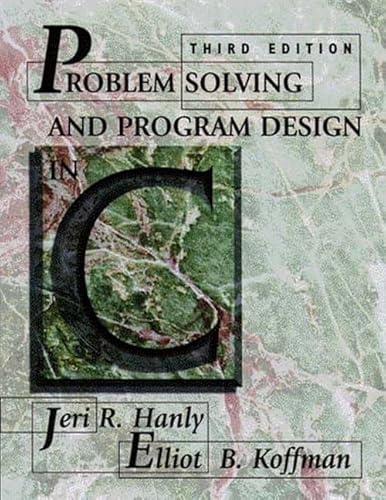
Synopsis
This bestselling text maintains its classic features like the gradual introduction of pointers and the connection between problem solving skills and effective software development. It features early coverage of functions, logical operators, and operators with side effects. The third edition offers updated C code and provides a new "On to C++" chapter, preparing students for future object-oriented programming and C++ courses.
"synopsis" may belong to another edition of this title.
About the Author
Jeri R. Hanly is a member of the computer science faculty at the University of Wyoming. She has developed software for target recognition in collaboration with naval researchers in China Lake, California and has taught software engineering seminars for professional developers of computing systems in the U.S. and Canada.
Elliot Koffman is a professor of computer and information science at Temple University. He is one of the country's foremost CS educators, a former chairman of the ACM Task Force for introductory programming methods courses, and author of a number of successful language texts in Modula-2, FORTRAN, in addition to his four editions of Pascal and Turbo Pascal.
0201357488AB04062001
From the Back Cover
This bestselling text maintains its classic features like the gradual introduction of pointers and the connection between problem solving skills and effective software development. It features early coverage of functions, logical operators, and operators with side effects. The third edition offers updated C code and provides a new iOn to C++i chapter, preparing students for future object-oriented programming and C++ courses.
0201357488B04062001
"About this title" may belong to another edition of this title.
Other Popular Editions of the Same Title
Search results for Problem Solving and Program Design in C (3rd Edition)
Problem Solving and Program Design in C
Seller: Better World Books: West, Reno, NV, U.S.A.
Condition: Fine. Used book that is in almost brand-new condition. Seller Inventory # 42746774-75
Problem Solving and Program Design in C
Seller: Better World Books, Mishawaka, IN, U.S.A.
Condition: Very Good. Former library book; may include library markings. Used book that is in excellent condition. May show signs of wear or have minor defects. Seller Inventory # 21409523-20
Problem Solving and Program Design in C
Seller: Better World Books, Mishawaka, IN, U.S.A.
Condition: Good. Used book that is in clean, average condition without any missing pages. Seller Inventory # 3148445-6
Problem Solving and Program Design in C (3rd Edition)
Seller: Wonder Book, Frederick, MD, U.S.A.
Condition: Good. Good condition. 3rd edition. A copy that has been read but remains intact. May contain markings such as bookplates, stamps, limited notes and highlighting, or a few light stains. Seller Inventory # E01A-02754
Problem Solving and Program Design in C (3rd Edition)
Seller: ThriftBooks-Dallas, Dallas, TX, U.S.A.
Paperback. Condition: Fair. No Jacket. Readable copy. Pages may have considerable notes/highlighting. ~ ThriftBooks: Read More, Spend Less. Seller Inventory # G0201357488I5N00
Problem Solving and Program Design in C, 3rd Edition
Seller: a2zbooks, Burgin, KY, U.S.A.
Softcover. Condition: Good. 3rd Edition. The text has light writing and highlighting, Shelf and corner wear to the books cover and corners. Binding is still in good condition. Scuffing, rubbing, and creasing to the books cover and corners. Quantity Available: 1. Shipped Weight: Under 1 kilo. Category: Computers & Internet; ISBN: 0201357488. ISBN/EAN: 9780201357486. Pictures of this item not already displayed here available upon request. Inventory No: 1561009710. Seller Inventory # 1561009710
Problem Solving and Program Design in C (3rd Edition)
Seller: Phatpocket Limited, Waltham Abbey, HERTS, United Kingdom
Condition: Good. Your purchase helps support Sri Lankan Children's Charity 'The Rainbow Centre'. Ex-library, so some stamps and wear, but in good overall condition. Our donations to The Rainbow Centre have helped provide an education and a safe haven to hundreds of children who live in appalling conditions. Seller Inventory # Z1-J-011-02037
Buy Used
Ships from United Kingdom to U.S.A.
Quantity: 2 available
Problem Solving and Program Design in C (3rd Edition)
Seller: BennettBooksLtd, San Diego, NV, U.S.A.
Paperback. Condition: New. In shrink wrap. Looks like an interesting title! Seller Inventory # Q-0201357488

